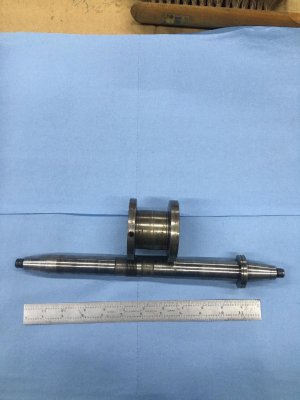As the title suggests, I am about to embark on a project. And I am unsure if I can (with my limited experience) achieve the needed accuracy.
So, if you guys don't mind helping me out I would greatly appreciate it.
The photo shows a spindle shaft from a Brown & Sharpe #13 universal grinder, around 1942 vintage. I hope to make another shaft that is about 1" longer, adding the extra outboard of the disc. I want to add a v-belt or poly rib pulley to that end so that I can run the spindle from a separate 2 hp 3 ph motor instead of the flat belt that it originally had. The original pulley is shown in pic also. The reason for changing is the flat belt flips over and cost $$$. From what I can tell the motor is too old and incompatible with a vfd that I would like to add also.
There are 3 things I would like to ask;
What would be the best pulley & belt size & style? (Max rpm around 3500 with 1750 rpm motor. Up to 8" wheels)
What suggested order of operations?
Best method of attaching the disc at the right end? Press fit, shrink fit, braze or solder? This disc acts as a end play stop.
The old shaft measures 0.996 in the unworn areas.
The new shaft is 1 inch diameter 1045 polished & ground and I plan to use hss tools. I have insert tools but I have more trouble with accuracy.
I also plan to keep the old parts to be able to return to original if the need arises.
Thanks in advance for your help
Chuck
So, if you guys don't mind helping me out I would greatly appreciate it.
The photo shows a spindle shaft from a Brown & Sharpe #13 universal grinder, around 1942 vintage. I hope to make another shaft that is about 1" longer, adding the extra outboard of the disc. I want to add a v-belt or poly rib pulley to that end so that I can run the spindle from a separate 2 hp 3 ph motor instead of the flat belt that it originally had. The original pulley is shown in pic also. The reason for changing is the flat belt flips over and cost $$$. From what I can tell the motor is too old and incompatible with a vfd that I would like to add also.
There are 3 things I would like to ask;
What would be the best pulley & belt size & style? (Max rpm around 3500 with 1750 rpm motor. Up to 8" wheels)
What suggested order of operations?
Best method of attaching the disc at the right end? Press fit, shrink fit, braze or solder? This disc acts as a end play stop.
The old shaft measures 0.996 in the unworn areas.
The new shaft is 1 inch diameter 1045 polished & ground and I plan to use hss tools. I have insert tools but I have more trouble with accuracy.
I also plan to keep the old parts to be able to return to original if the need arises.
Thanks in advance for your help
Chuck


